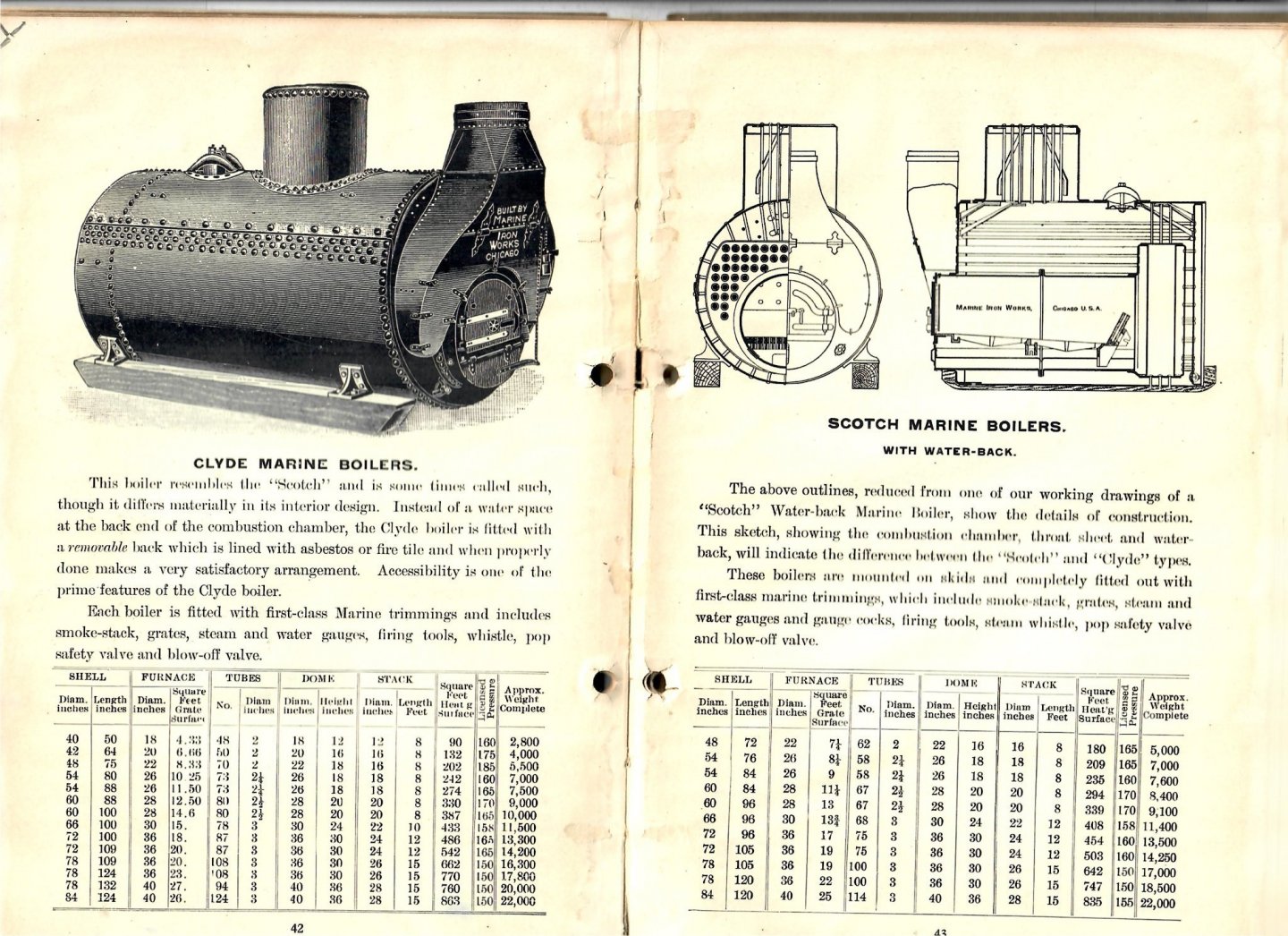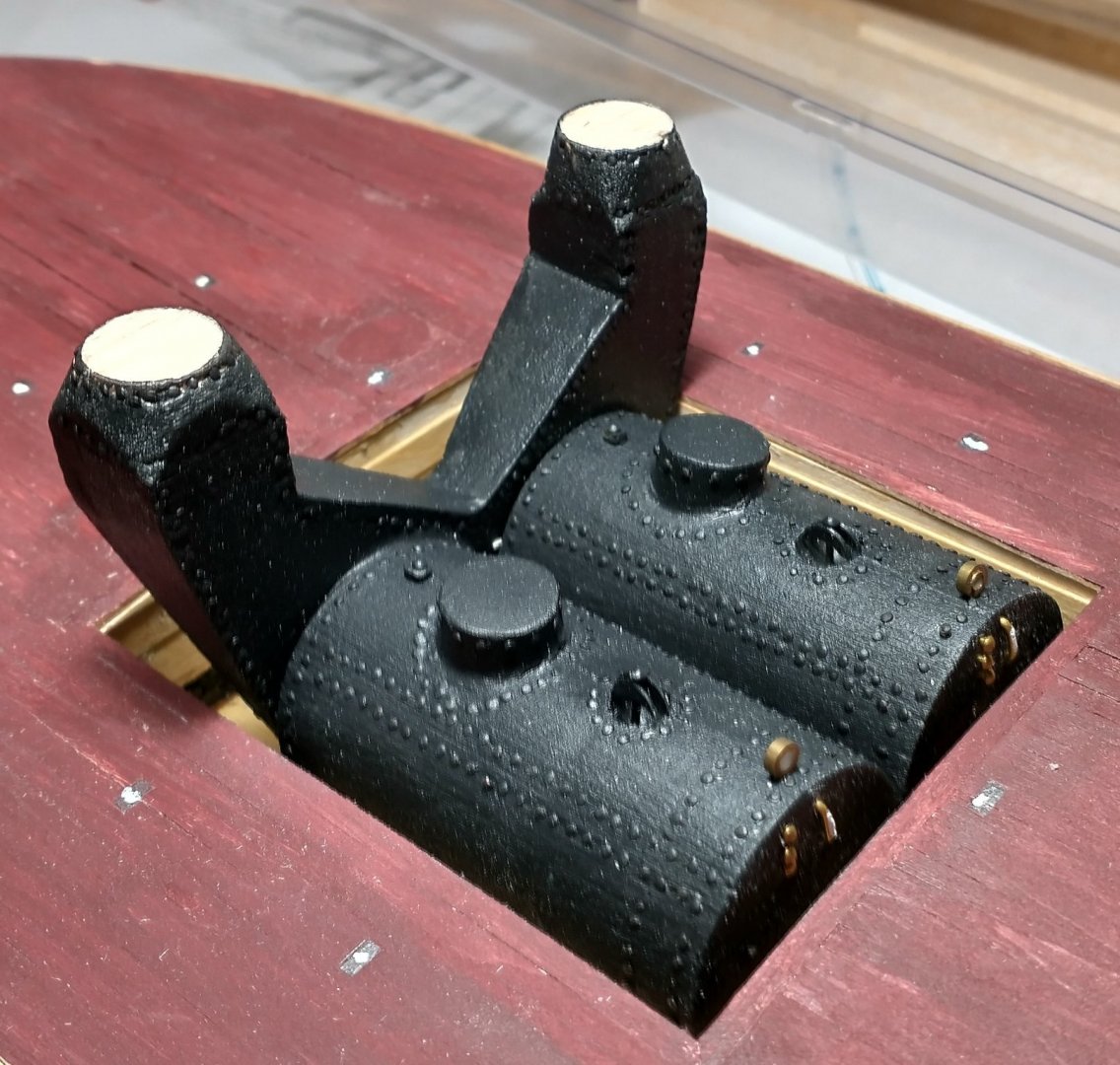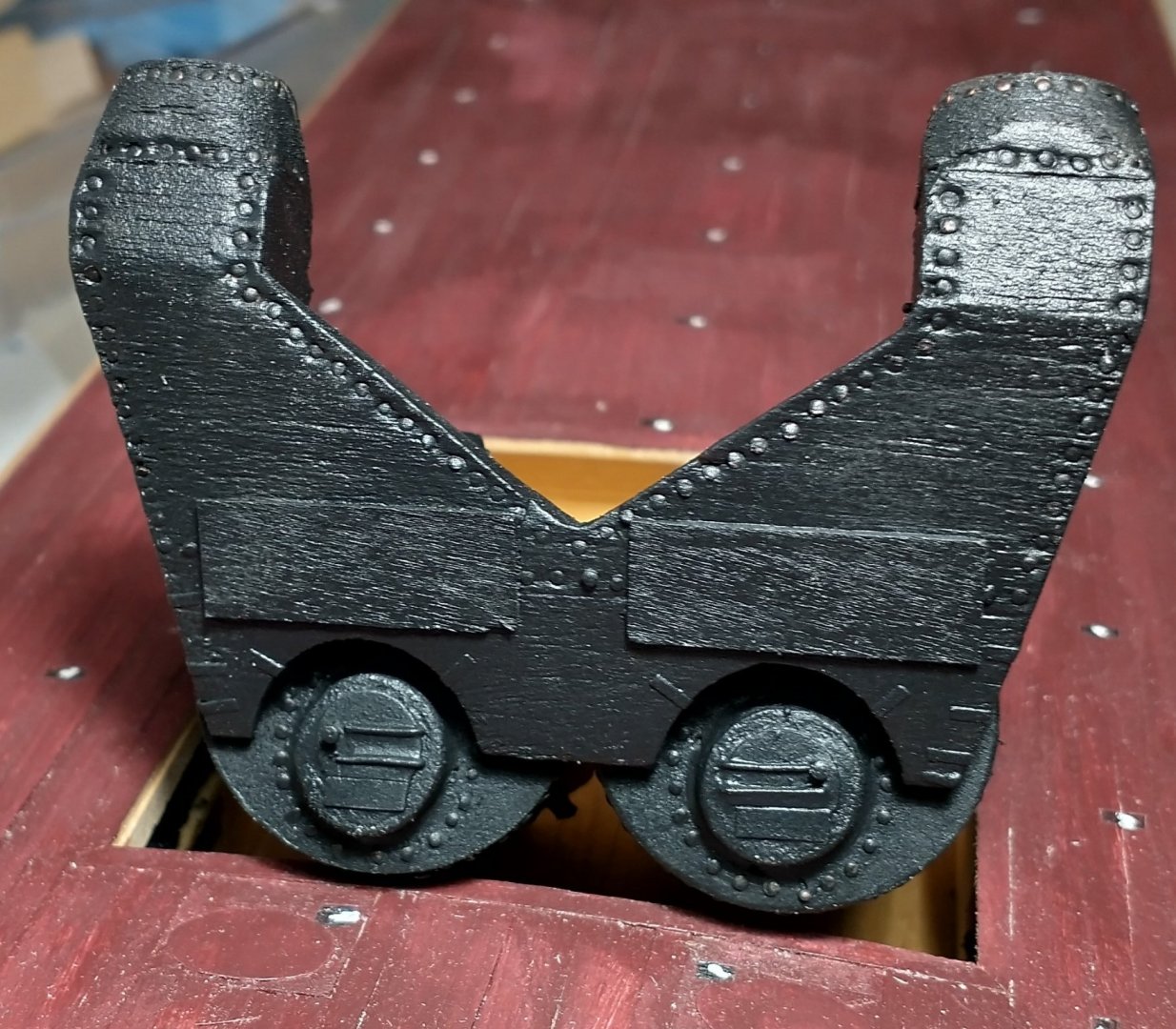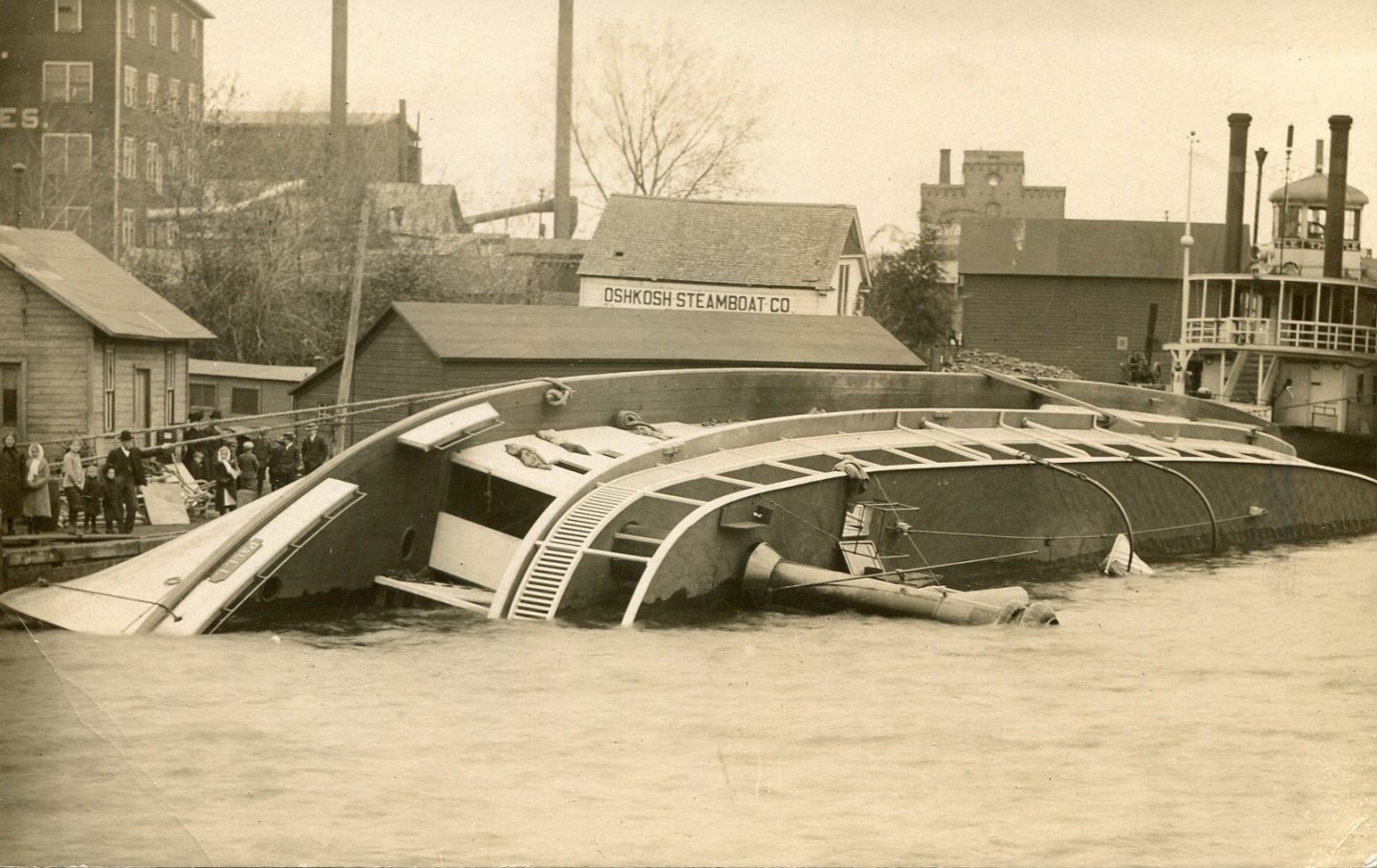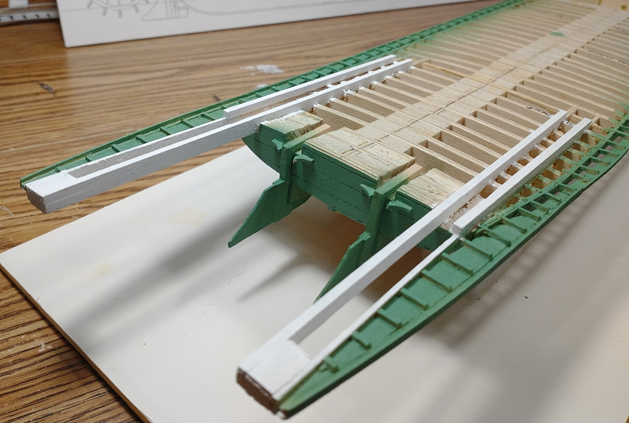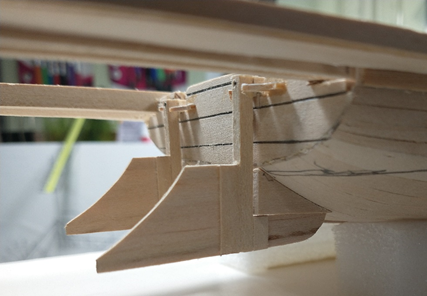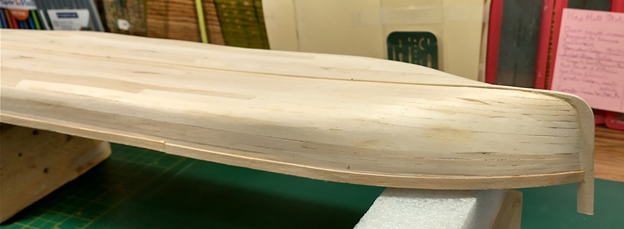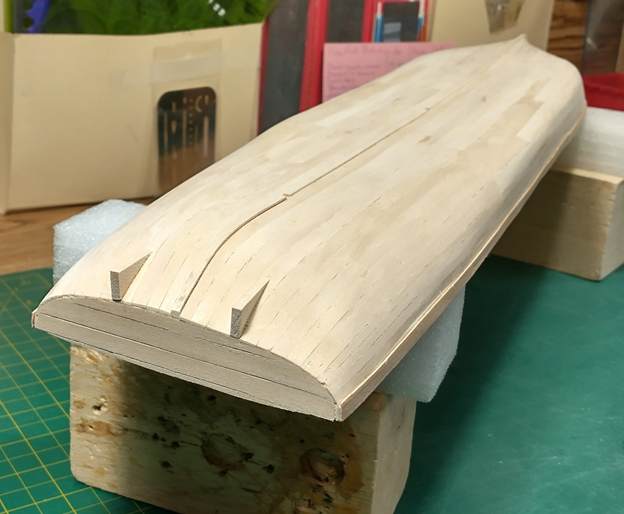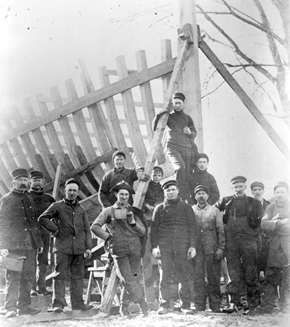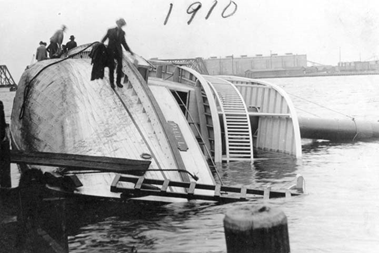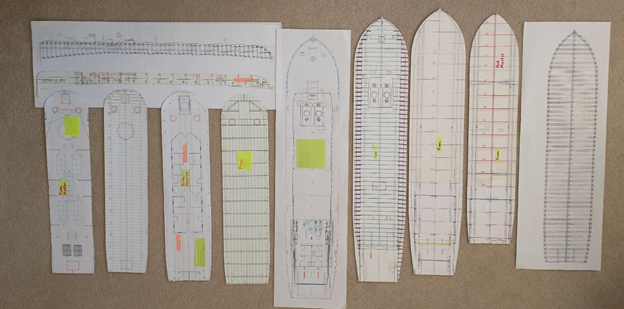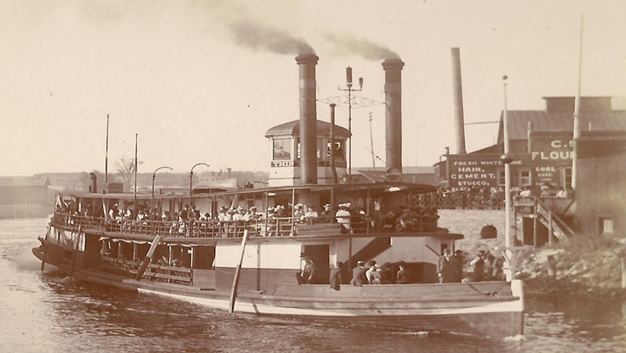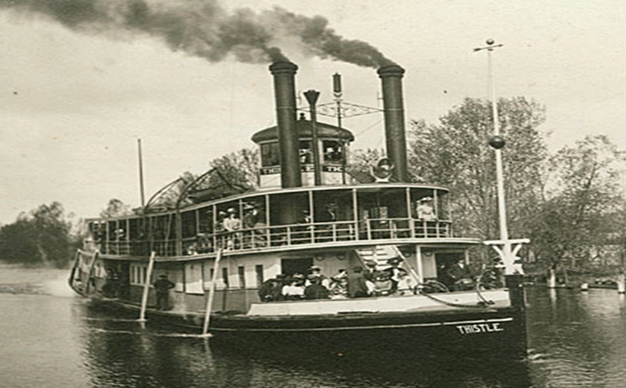-
Posts
159 -
Joined
-
Last visited
Content Type
Profiles
Forums
Gallery
Events
Everything posted by LJP
-
Hi Jim, Cathead & RevCol! Thanks for your comments. RevCol, there are not enough original paddle wheelers - I hope to see yours soon. I agree paddle wheelers are so neat! I built the boilers by using an appropriate diameter wooden dowel cut to length. Same for the steam dome and the firebox. Wood filler smoothed the connections of the steam domes and fireboxes to the boilers. I am not historically accurate as I did not cover the boilers in asbestos. Both Moyie and photos of local (Oshkosh, Wisconsin) Shattuck Park shipyards showed Scotch boilers covered in asbestos. The breeching is balsa. I made plans first, glued them onto the balsa and cut the breeching out. Ah, the rivets. I tried a few other methods, as built-up glue, and different sizes of pins and nails until I found one close to scale. Ultimately, I used 4 mm copper nails for the rivets. The nails were in a possible box (every possible thing known to mankind) and I have no idea where I acquired them from or when. I used a ponce wheel for the consistent spacing. I drilled holes for every last rivet on the boilers. These were the elements: Not a quick process, but I liked the results. What I have noticed is my modeling abilities are not what they once were but it is what it is. Back to the engines!
- 105 replies
-
I am back from attending to "other duties as assigned". The boilers took much longer than anticipated. I did not have the exact measurements for the two Scotch boilers but comparable Ryan Brothers boats included 4' by 12' boilers, so that is what I used. I used Marine Iron Works of Chicago advertisments as my guide. A scan from my original Catalog 18 follows. My built boilers, located within the hull follow. The white markings on the deck are placements for the upcoming stationairies. The steam lines from the steam drums to the main steam line will be added later. I was not certain how the breeching connected between the two boilers as I was unable to find a photo. Unlike the Western River boilers, Scotch boilers had flues beginning about halfway up the fireboxes. MIWC ads showed the lower part of the breeching was hinged for access. I added the heat shields. I will attempt the engines next.
- 105 replies
-
Thanks Jim! Brian welcome aboard! The Oxide Red turned out much darker than I anticipated. It hides a lot of the hatch details. I added a stained and roughed up rubbing strake. One Thistle photo showed a second, much shorter strake on top of that strake. Since this did not seem common, I omitted the second rubbing strake. I will begin making machinery before I start the structures. I will need the two Scotch marine boilers, boiler and auxiliary feed pumps, two hand pumps. a dynamo and two poppet engines. I will probably do the pitmans and paddle wheel later, although I already have made the pillow blocks. LJP
- 105 replies
-
Hi All, The main deck planking is done, now is time to paint the deck oxide red. The bow still needs two hawse holes for the anchor chains as Thistle had bent arm kedge anchors. I did put a hatch there for access to the suspected chain locker/collision bulkhead. When Thistle had one of its literal run-ins with a rock that punched a hole in its bow, it was noted that the forward compartment filled but water did not reach the coal bunkers. I also need two hog chain holes. In addition to the normal hog chains, Thistle had hog chains that seemed to run from the front of the boilers, through cutouts in the boiler room doors, and then into the hull by the main stairway. Here is the planked main deck. The two oblong metal hatches in front of the boiler pit are the coal chutes, just like on the Paul L. . I also included two main hatches. Lastly, I put a hatch in the engine room, not unlike the S. S. Moyie. These latter three hatches, along with the one for the chain locker, are a best guess on my part as I have no Thistle photos to confirm what and where the hatches actually were.
- 105 replies
-
Hi Kurt, Thanks for the quick heads up on the Badger Anti-Fouling Red Oxide. The colour I have is Model Expo's Hull Red. If you can believe the laptop colours when you Google your Badger or Floquil paints, the Model Expo seems close to your Badger Oxide Red. The Floquil seems a bit more brown but the swatch was very small and came from a colour chart. Your comments on steamboats and barns is really helpful. I have no experience with steamboats but do have lots of Wisconsin experience with barns - having painted my uncles barns red in my very young years. My memories may not be that accurate anymore but I want to say that barn red was not unlike railroad boxcar red. LJP
- 105 replies
-
Hi Roger I really appreciate your comments on determining colours in black and white photos. Like you, whatever is out there seems to point to you cannot determine the colour. I thought that colourized black and white films had some insight but that also is not true. Cathead, Thanks for looking at the photo and helping confirm my thoughts that the decks were covered. From what I read, the canvas was either painted or varnished to ensure longevity. Some referred to sand being added - probably to make the surface less slippery. I had hoped to have completed the main deck by now but it is taking much longer than anticipated. Part of the delay is "other duties as assigned". So I will stay at laying planks for a bit longer before I paint. I thought I would use a hull red but that may be too dark. I will test a sample to see how that looks before I do the whole main deck. LJP
- 105 replies
-
Hi Bob! Never thought of Michigan State colours! My red will not be Bucky Badger Red but a dark oxide red like a hull red so the people in Madison will still not approve. LOL Cathead, Here is the best Paul L. photo postcard that I own for deciding to use canvas on the boiler deck. You can definitely see the deck planks on the main deck, but the boiler deck - especially around the stacks and by the railings - looks just like the covered hurricane deck. The other issue is what colour the boiler and hurricane decks should be. I know the article referred to the "decks", as in plural, being red, but everything I have seen and read seems to point to a grey colour and not red. Again, any input would be greatly appreciated. Hi Keith! Welcome aboard! Hope you find this interesting. I am still working on planking the main deck. I have mocked up some Scotch Marine boilers and finished off the boiler pit, since Thistle's boilers were located within the hull and not on the main deck. I need to make certain the stacks line up through the boiler deck. I have struggled somewhat in portraying the coal in the bunkers but I think I have a reasonable approximation. I do not have the measurements of any of the boilers used in Thistle. Similar Ryan built boats did have two 4' by 12' boilers, so that is what I am using. [The Paul L. had a single 9' diameter boiler that was described as the largest Ryan installed boiler at the time.] In a really odd twist, a boiler from when Thistle was scrapped ended up in an Oshkosh school. There was a real bad newspaper photograph of that boiler when the school was demolished in the 1960s. I would loved to have had a clear and usable photo. The decking will take a few weeks as I attend to family duties.
- 105 replies
-
Over its 21-year lifespan, Thistle had numerous paint schemes. Unfortunately, black and white photos, “colorized” postcards of dubious accuracy and generalizations of “light colors” help little in arriving at accurate paint schemes. Luckily, the May 6, 1907 Oshkosh Daily Northwestern newspaper (via Newspapers.com) presented that: ” decks being colored red, the hull in sea green, the cabins in grey and the rails and stairways in white.” By that time, the hull below the waterline was covered with two coats of boiled linseed oil instead of paint. This will be my paint scheme for Thistle. On how paint was made, according to Donald Jackson in his Voyages of the Steamboat Yellow Stone [Ticknor & Fields, 1985] “Because all paints were mixed on the job by adding various pigments to white lead or linseed oil, the order called for lampblack, bluish-green verdigris (a copper compound), red litharge (a lead compound), yellow ochre, copal and Japan varnishes, and, of course, turpentine in large quantities.” For my model, the sea green that was used is comparable to the sea green used in the pilothouse of S. S. Moyie. The grey will be comparable to the original grey paint on the Steamboat House at Marble Park in Winneconne, Wisconsin. The red will be a darkened red more period specific than the bright reds now seen on current sternwheelers. Boiled linseed oil was used on the hull below the waterline. Interior main deck colors will be white upper and a yellow lower. The yellow will be comparable to the yellow on steamboat relics in the Steamboat Graveyard across from Dawson City. Thistle was described as having between 3 to 3 ½ feet of draft. There is a side profile of Paul L. at the Oshkosh Public Museum site that shows what the bottom and sides of Paul L. looked like. I would expect that Thistle would have looked much the same. Note the photo of the Paul L. was from after the May 1910 capsizing as there are now straight stacks unlike the earlier “Thistle Like” stacks that had rings at the top of the stacks. The link, if you should so desire: Steamboat Paul L. - P1182.119 (pastperfectonline.com) I gave the bottom of Thistle’s hull the historical description of two coats of boiled linseed oil and nothing else. This looks like uncolored varnish. The photo of the Paul L. shows a much darker bottom. By that time Paul L. would have been in service nearly three years and the bottom would have been much dirtier. I suppose that I could have aged Thistle’s bottom to reflect that aging. The sides, the guards and the rudders were spray painted Ocean Green. The underside of the main deck planks over the guards will be this same color. I was not concerned about the overspray as the deck planks will cover this. There are colorized postcards of Thistle that show green bottom or sides that are close to that ocean green. Again, artistic license may have impacted the colors chosen on the postcards. This is what the model looked like after the hull was painted. I was uncertain about the cylinder timbers so I painted them white. There is always a discussion of tarpaper or canvas on decks. The birds eye photos of Thistle and Paul L. provide no clarity as to which was used. There are photos of Yukon steamboats where canvas was being laid. The S. S. Moyie described where canvas would last about five years on the decks, and several layers were present on the decks when the boat was renovated. Canvas was used on Thistle on the main deck above the bulwarks for shading so it was already in use on the boat. “Canvas, painted and sanded” will be used instead of tarpaper. I know that a covering was used on the hurricane deck based upon both Thistle and Paul L. photo postcards. In the capsized Paul L. photo postcards, the main deck was left uncovered. The Paul L. boiler deck seemed to have been covered. The much smaller boiler deck was also covered on Moyie. I would appreciate input from others on whether the boiler deck should have been covered or not. I know most models show this of not being covered so if I were to cover the boiler deck that would be a huge departure from the norm. I am trying to get more photos of the capsized Paul L. to try and provide more clarity. The main deck is next up. This will take some time.
- 105 replies
-
To create the guards, I used the photos from the capsized Paul L. The outrakers were placed at a scale 22 inches on center. I created a jig, which is seen in the bottom center of the photo below, to be consistent in placing the distances. The outside planks (no idea what these were called) were affixed to the underside of the outrakers and the inner rubbing strake. The cylinder timbers had to be added at this point to complete the guards. I always tried to think several steps ahead in order to prevent rework or creating much more difficult processes. I was not always successful in this endeavour. This is a shot of the work in process. This is what the final result looked like. The two balanced rudders replicated what was on the Oshkosh Museum stern photos. This is where I had one of my “should have thought farther ahead” moments. The transom needed have a section removed between the cylinder timbers to accommodate the eventual pitmans. And the transom needed to have a section removed between the rudder stops for the rudder tillers. I chose to have the tillers beneath the main deck. I had seen some sternwheelers that had the tillers on the main deck (which used up a lot of usable deck space) or placed under the boiler deck. In this latter case the rudder post had to extend up between the transom and the false transom. This method affected the main deck if it extended beyond the transom to the false transom. This is a photo of the rudders and rudder stops before: final finishing, being secured, gudgeons & pintels added, or painting. I had also drawn a temporary waterline I now need to paint the hull before starting on the decking and stationaires.
- 105 replies
-
Cathead and John, Thanks for the praise. Just a heads up, I am out and about and will not be able to respond for about another week. Summer is short and family duties are long. Thanks, LJP
- 105 replies
-
I had not planked a hull in a long time and it showed. Unlike Chaperon, Bertrand and others that had bottom planks that were flat, Thistle had planks that bent at the stem and stern, not unlike a clipper ship. Thistle did have bottom planks that were considerably wider than the side planks as noted in the Paul L photos. Thistle’s actual bottom planks were made of oak, and the side planks of Eastern white pine. Paul Ls. bottom planks were made of Cyprus and the side planks Douglas fir. Keels of both were local oak. The 1894 Thistle was able to use local wood but the supply was depleted by the time of the 1907 Paul L. Initially, I tried just tapering the planks. Huge mistake. I removed the mistake and decided to do it the correct way with spiling the planks. I referred to Model Ship World articles on the process and consulted a 1980s vintage book that I owned on planking. I used poster board to create the templates for each row of planks. That was much easier to bend and trim than the actual basswood planks. One template could be used for both the port and starboard side. It was heartening to discover that my hull was symmetrical. The wood planks still required beveling the edges and bending. My keel frame did not have the stem post attached. Instead of cutting in the rabbits, I ran a 1/16 square stock from stem to stern on the keel frame. The planks then abutted this. The frame at the stem was tapered to meet the 1/16 square stock and the ends of the planks tapered to meet the square stock. After the hull was planked, I ran wider stock over the smaller square stock on the bottom to portray the keel that Thistle had. A stem post was added. The stern had a curved stock to follow the spoon shaped stern. In this photo, I had just started the correct planking process. Note the line demarcations on the frames where the individual planks were to be affixed. I started with few planks by the sheer strakes to add stability. I then went down to the keel and garboard strake and planked from there up. The second product looked much better than the first try. Off to building the guards and rudders.
- 105 replies
-
Hi Bob & Roger! I am back. I really struggled with the hull. I also have an admission: the planked hull is complete and I am currently working on the guards and rudders. I will go through my process, my mistakes and reworks. I wanted a complete hull before I started my post because I had no idea how long it was going to take or how many blind alleys I would follow. Both were time and mistakes were considerable. Creating the hull for the Thistle included two main sources. The hull sheer came from Thistle photos. But I had no idea what the hull was like below the waterline. Instead, I used Paul L. photos as capsized to create the water and rib lines. Thistle and Paul L. had virtually identical hull dimensions, had the same builder (Ryan) and the same owner when the Paul L. was built (LeFevre). There are several photos that I found the helpful in creating the hull. This is the bow of the Paul L. while under construction. George Ryan is the man in the center. Note the massive stempost (Thistle’s was even larger), the bow frames were not canted, and beginning with the 7th frame, the frames are doubled up to the water line. This construction was typical for Ryan based upon accounts of other Ryan built boats. Reprinted with permission Neenah (Wisconsin) Historical Society. A bow photo that shows the flat bottom, a true keel, rounded futtocks, and a sharp model bow. Reprinted with permission Neenah (Wisconsin) Historical Society. There are several other bow shots that I consulted during the build. I also own several postcards of the capsized Paul L. There are two Paul L. stern photos from The Oshkosh (Wisconsin) Public Museum – the links are provided below. I was not timely in requesting permission to reprint here but the links will bring you to the low-resolution photos. Note the balanced rudder, the Ryan “spoon shaped stern” described in period articles, paddlewheel detail and other items. The museum has high quality digital jpg’s for purchase, which I did purchase. The enhanced digital photos are clear enough to permit the number of planks to be counted. This was incorporated into the model. You could also see many of the bolts which held the planks to the frames. Steamboat "Paul L " Capsized - FP2003.20.734 (pastperfectonline.com) Steamboat "Paul L " Capsized - P6767.2 (pastperfectonline.com) Interestingly, the barged-out hull of the Paul L. lies under water in the Fox River between locks 2 & 3 in Appleton. It was dived on by scuba divers and a video created in about 1995. The green mossy hulk was interesting but not helpful in the build. A quarter century later I was not willing to have more scuba divers hopefully locate and once again dive on the wreck. The video, should you like review it, is located at: https://archive.org/details/WiscRiverboats I consulted Bertrand’s lines to help me. John M. Sweeney’s contemporary River Practice of the West from the Transactions of American Society of Mechanical Engineers (Volume IX) provided lines and hull cross sections. Circa 1890’s, I am lucky enough to have an original copy of this. The Institute of Nautical Archeology has a whole series of Yukon sternwheeler articles. In many respects, Fox and Yukon boats were very similar. My first step was to build a full-scale rough bulk head hull model using architectural foam and balsa. Many, many iterations and adjustments later, I sliced it into sections to create the frames. I decided to build a plank on bulkhead hull for the model instead of using actual individual frames like the real hull would have used. My generated frames did not line up with where the expected actual frames would have been. But I will be able to take the lines off of the plank on bulkhead hull should I decide to build another Ryan sternwheeler. But not now. This is what the completed framing looks like. The open, boxed in area is for the boiler. Ryan used Scotch Marine boilers located within the hull instead of Western River boilers which were typically placed on the main deck. I tried using bulkheads with a cutout for the boiler but those were incredibly weak and I broke numerous ones before I used this box layout. Photos of the hull of the Yukon sternwheeler Gleaner show how the supports for a boiler installed in a hull looked. You can find the Murray Lundberg photos posted at http://explorenorth.com/library/ships/bl-gleaner.htm A bit of a diversion here. Gleaner’s machinery came from the Marine Iron Works of Chicago USA (MIWC). MIWC provided actual blueprints for building the sternwheeler when all the machinery was provided by them. So, the remains may be from a set of those blueprints – which I have been unable to locate. Alternatively, MIWC also provided a compete hull in knockdown form which was then sent to the owner along with the machinery and blueprints. The owner then reassembled the hull. The next section will cover how I planked the hull.
- 105 replies
-
Hi Tony, I am really looking forward to the wheelhouse also. From the pilothouse's size perspective, Thistle's wheel was described as "about six feet across". Emil Steiger, one of the owners, loaned the wheel to the Oshkosh Yacht Club when Thistle was dismantled. I am unaware if it is still there. I really like the roof but expect it will be a problem to model. Many of the actual roofs were tin over wood framing. Steamboats.com Online Museum - Dave Thomson Wing has photos of the pilothouse of the Golden Eagle that shows how the inside structure was built. I will be posting the hull construction in about a week. In the meantime, I will be unavailable. Thanks, LJP
- 105 replies
-
There were no plans of Thistle that I could find so I needed to create my own. I have really tried to make them as accurate as possible. There was a model of Thistle made years ago. It may have been lost when the Oshkosh Public Museum had a fire that destroyed their steamboat section in the 1990’s. I decided on a 1:64 scale. Thistle’s overall nominal length was 144 feet, so the scale length was just under 24 inches. Just the right length to fit on my shelving while still allowing for enough detail. I was able to obtain only a few actual Thistle measurements beyond the legal dimensions. One of the most important was that the height of the bulwarks plus railing was 3 ½ feet. With my trusty digital calipers, I began measuring numerous components on the even more numerous photos. I filled up many Excel spreadsheets with computations. I tried to recreate the same measurements using several different photos in order to ensure accuracy. Then I starting drawing plans – again and again and again. It truly took a long time and many iterations before a final set of plans was complete. While the side profile took some time, to get the top-down drawings and profiles to accurately tie out required many revisions. Simply put, if the measurements were not correct the two would not fit together. This is what my Thistle will look like. The time period is about 1910 to 1912. I did top-down plans for each deck and another for each underside showing the beams and carlings. This latter was really important in improving placement for the various components. I included the hull even though I will do a plank on frame hull. I really needed to understand where things were placed within the hull so I can accurately place the items above the hull. Hope this all makes sense. These are the eleven sheets that created. Some have already been tweaked as I started the build. I also created but have not included a stern and bow profile. I started this project with very little knowledge of sternwheelers. I took numerous detours here as I headed off to learn more about steamboats in general and the Fox-Wisconsin Waterway and its steamboats. I reviewed other Fox-Wisconsin Waterway boats and other Ryan built boats. The most helpful by far was the sistership 1907 Paul L. (as in LeFevre). In May 1910, the Paul L. was unloading coal at an Oshkosh dock. Amazingly, the coal was off loaded from only the starboard side and not the port side. Results were predictable. The Paul L. capsized. This was bad for the Paul L. but great for me as a modeler. Numerous photos of the catastrophe were taken. These provided a level of detail normally not available. Especially helpful were the details of the hull including two stern views that is online at the Oshkosh Public Museum. Primary general information came from the “usual suspects”: Bates, Kane, Hunter, Petsche and Sweeney. I followed what others had done on Model Ship World (Thanks Cathead!), obtained William F. Wiseman’s Nautical Research Guild articles on the Myrtle Corey and Far West and Kurt Van Dahm’s Chaperon from Ships In Scale. Websites of existing period sternwheelers included the S. S. Sicamus and S. S Moyie. There are many, many other sources too numerous to mention here, but the Institute of Nautical Archeology’s Yukon studies were very helpful. There are many other steamboat related websites that were used. Periodicals as Beeson, the American Bluebook of Shipping, and brochures from the Marine Iron Works of Chicago USA provided valuable information and details on period equipment. And there are tons of books which provided general or information specific to one steamboat. I became a voracious reader during the cold Wisconsin winters. With the “final” plans in place, I started the hull.
- 105 replies
-
Hi All, Roger, Thanks for making me an honorary Great Laker! My early life was on the shores of the Lake Michigan, with carferries and fish tugs out my back door. chborgm, glad to see you did both the Chaperon and Portland. Two very different but wonderful steamboats. Kurt, after the lapse in time, you probably thought that I had abandoned the project. Actually I was doing research as I started with very little knowledge of sternwheelers. I now have learned a lot but am amazed at how little I still know. I cut the six parts of your Ships In Scale Chaperon article out and have referred to them as I have progressed. It has been very helpful. Bridgman, no one was more surprised to learn about steamboats on the Fox than me. I hope to post the plans section later today.
- 105 replies
-
Hi Cathead, Jim & Tony Thanks for your interest! Cathead, I loved your builds and followed them closely. I should be able to post the plans section in the next day or so. LJP
- 105 replies
-
It has been a while since I began this process. And … it will be a while before it is completed. I first became aware that there even were steamboats in the Fox River Valley when I got a copy of D. C. Mitchell’s Steamboats on the Fox River. I loved the book and all of its photos but Thistle’s octagonal pilot house caught my attention. Thus began a long research and drafting process. The Thistle was built as the J. H. Crawford in 1894 by Ryan Brothers of Oshkosh, Wisconsin for the Wolf River Transportation and Merchandising Company. George Ryan and his brother were Canadians who learned shipbuilding at Short Brothers in Maine. They also built Great Lake boats in Sheboygan and Manitowoc before they finally began ship building in Oshkosh. This background had a profound effect upon the vessels they built. They modeled and lofted their boats. And George never referred to their creations as boats, they were always “ships”. Their boats were what Hunter called the Mosquito Fleet as their size was limited by the 145 by 36-foot Fox River locks. Their long-lived boats were strongly constructed to weather the shallow but tempestuous Lake Winnebago. The J H Crawford was nominally 130 feet long overall with a 25-foot beam. The new owners immediately had a falling out over the proposed Wolf River route for the Crawford. Eight months later the Crawford was sold to the company of McKenzie & [ John H.] Crawford. In 1899 they in turn sold the Crawford to Clark and LeFevre. Clark & LeFevre lengthened the boat by 14 feet and renamed it Thistle. Clark & LeFevre combined interests with the Oshkosh Steamboat Company in 1906. Thistle was finally dismantled at Green Bay in 1915 after a long 21-year life. Thistle had two distinct looks during its life: . Thistle at Berlin, Wisconsin in 1901. Note the double stairs to the saloon deck, main deck with bull rails but without windows or mid-deck bulwarks. The bow bulwarks were added in 1901. This is what the J. H. Crawford probably looked like, albeit 14 feet shorter. Reprinted with permission from the Berlin (Wisconsin) Area Historical Society Thistle at Omro during the period 1904 to 1909. Now there was a grand staircase to the saloon deck, the main deck had windows and there was a mid-deck enclosure. The bull rails were replaced with bulwarks – a very unusual feature. Note the fore bulwarks had a canvas shade drawn down over it. This was used periodically to protect passengers from the elements. This is one of my numerous postcards. The usual routes used by Thistle were on the Lower Fox River from Appleton to Green Bay, the Upper Fox as far as Berlin, the Wolf River as far north as New London, and the east coast of Lake Winnebago. The boat was initially a packet on a regular schedule with freight and passengers. Later years it was primarily used for excursions and for hauling bulk freight, as coal, lumber and wire grass. It was a day boat with no overnight accommodations for passengers although the captain and crew were housed on the boat. Thistle had a normal but long life. This included strandings, sinkings, fires, and unfortunately deaths. The ice-free season was short – typically from mid-April until November – and was dictated by the federal government as to when the bridges and locks would be staffed. In one instance, Thistle used its anchors to break the ice but the ice still cut an inch into the gangplanks which had been hung over its sides. Thistle also ran backwards to use its paddlewheel to break either the ice or the floating bogs that formed in the shallow lakes. But it was ice that eventually caused its demise. In November 1913, Thistle was driven ashore in ice on the east side of Lake Winnebago. Although rescued and run during 1914 season, that damage, a decreasing business, two newer underutilized sternwheelers and a budding World War I could not justify the cost of repairs. It was sent to the breakers in August 1915. Thistle was an excursion craft during a period when many photos were taken and many were used in creating postcards. I ended up with more than 40 photos of Thistle. I bought some on eBay, some came from the D. C Mitchell book, while others came from museums, historical societies and libraries. NewspaperARCHIVE and Newspapers.com provided local period newspaper articles. Local magazines, articles and books contained helpful information. A trip was made to the Steamboat House at the Winneconne Historical Society Museum in Marble Park. Its sole surviving Fox River Valley steamboat superstructure includes some incredible original staterooms. I was very busy taking measurements and photos. In my next post, I will describe how I made Thistle’s plans and include some of those plans.
- 105 replies
-

Steamboats and other rivercraft - general discussion
LJP replied to Cathead's topic in Nautical/Naval History
Incredible photos!- 281 replies
-
- Steamboats
- riverboats
-
(and 3 more)
Tagged with:
-
Eric, will this be recorded on YouTube or Zoom so it can be viewed later? I have a conflict at that time that I cannot break. Thanks, LJP
- 599 replies
-
- sidewheeler
- arabia
-
(and 4 more)
Tagged with:
-
Excellent! Your model is exquisite! And I have ordered an NRG 2021 calendar. LJP
- 599 replies
-
- sidewheeler
- arabia
-
(and 4 more)
Tagged with:
-
Just got through binge reading your post on Arabia. Wonderful work! Along with your Bertrand, your skills are truly exceptional. I especially like your hull construction on both models. Few people are willing to take a crack at models such as these. I can hardly wait to see the finished product. LJP
- 599 replies
-
- sidewheeler
- arabia
-
(and 4 more)
Tagged with:
-

Steamboats and other rivercraft - general discussion
LJP replied to Cathead's topic in Nautical/Naval History
Hi Mark, Really neat local sternwheelers! Hard to choose which is the "best". The 50 foot waterline model looks exactly like a Marine Iron Works of Chicago sternwheeler. If you have not acquired a copy of a 1986 reprint of their catalog you may wish to do so. I am certain you will find it both interesting and helpful. I wish you the best of luck making plans and then scratch building. It may not be a fast process but it will be incredibly gratifying. Larry- 281 replies
-
- Steamboats
- riverboats
-
(and 3 more)
Tagged with:
-

Steamboats and other rivercraft - general discussion
LJP replied to Cathead's topic in Nautical/Naval History
Hi Bill! Thanks for the info, sounds like someone who has insights from prior trips there. And looking forward to the wine. Thanks, LJP- 281 replies
-
- Steamboats
- riverboats
-
(and 3 more)
Tagged with:
-
Thanks Fright! Getting closer to drawing plans. Amazing how sources you would never think to use are incredibly helpful and ones that you expect to use wash out. LJP
-

Steamboats and other rivercraft - general discussion
LJP replied to Cathead's topic in Nautical/Naval History
Hi Eric, older people can also be dumb. I speak from experience. I should have also spent more time there and taken more pictures. And I never knew about the Evelyn on Shipyard Island until years after. But I appreciate what I have done and learn from it. So next time... Hi Bill, Thanks about the Sicamous info. Very impressive. There are YouTube videos about Sicamous that are great. And I would like to visit Moyie in Kaslo at the same time. In the next few years I want to head back to Vancouver and these two stops are definitely an add-on. Thanks LJP- 281 replies
-
- Steamboats
- riverboats
-
(and 3 more)
Tagged with:
About us
Modelshipworld - Advancing Ship Modeling through Research
SSL Secured
Your security is important for us so this Website is SSL-Secured
NRG Mailing Address
Nautical Research Guild
237 South Lincoln Street
Westmont IL, 60559-1917
Model Ship World ® and the MSW logo are Registered Trademarks, and belong to the Nautical Research Guild (United States Patent and Trademark Office: No. 6,929,264 & No. 6,929,274, registered Dec. 20, 2022)
Helpful Links
About the NRG
If you enjoy building ship models that are historically accurate as well as beautiful, then The Nautical Research Guild (NRG) is just right for you.
The Guild is a non-profit educational organization whose mission is to “Advance Ship Modeling Through Research”. We provide support to our members in their efforts to raise the quality of their model ships.
The Nautical Research Guild has published our world-renowned quarterly magazine, The Nautical Research Journal, since 1955. The pages of the Journal are full of articles by accomplished ship modelers who show you how they create those exquisite details on their models, and by maritime historians who show you the correct details to build. The Journal is available in both print and digital editions. Go to the NRG web site (www.thenrg.org) to download a complimentary digital copy of the Journal. The NRG also publishes plan sets, books and compilations of back issues of the Journal and the former Ships in Scale and Model Ship Builder magazines.

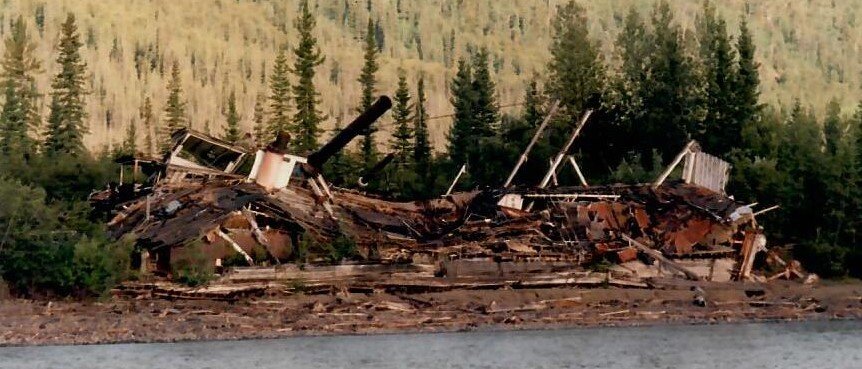
.thumb.jpg.d7978015ba54e7dac717354d00d3763c.jpg)


